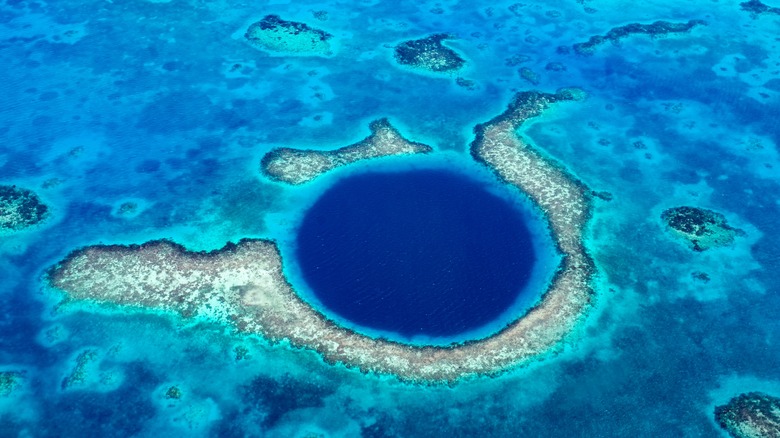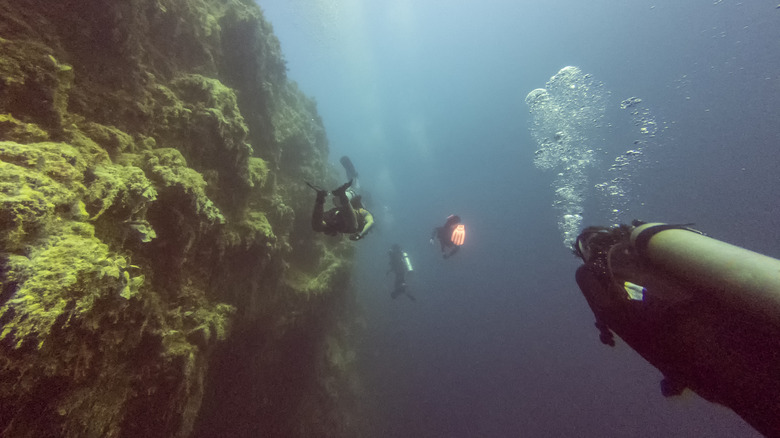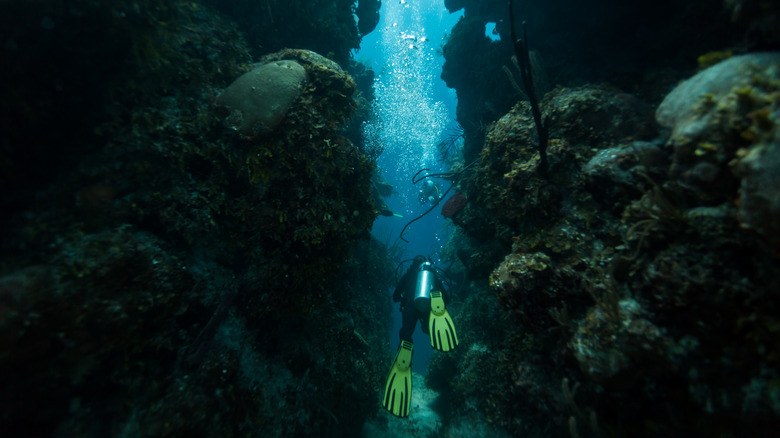Why Belize's World-Famous Great Blue Hole Dive Site Can Be So Dangerous
The Great Blue Hole, located 62 miles off the coast of Belize in Central America, is one of the most iconic dive sites in the world. This giant marine sinkhole, measuring about 1,000 feet in diameter and plunging over 400 feet deep (it's even visible from space!), draws thousands of divers every year, intrigued by its mysterious depths and underwater wonders. While its crystal-clear waters promise an unforgettable scuba diving experience, the Great Blue Hole is also one of the most dangerous dive sites in the world.
Before it became submerged, the Great Blue Hole was a limestone cave system that stood on dry land. Around 15,000 years ago, during the last Ice Age, rising water levels flooded the tunnel-like caverns and caused the entire ceiling to collapse, leaving behind what we see today: a circular underwater karst-eroded sinkhole, the largest of its kind. It is surrounded by the Lighthouse Reef, a small atoll, part of the greater Belize Barrier Reef Reserve System (one of the world's most beautiful coral reefs), which is a UNESCO World Heritage Site.
Diving the Great Blue Hole was initially popularized by the explorer Jacques Cousteau in the 70s, and its fame has become cemented ever since in the collective consciousness. The reef surrounding the hole, with groupers, gobies, and giggly corals, is a major draw, but once you go into the hole, everything changes. Inside, expect to see enormous stalactites (some are 40 feet long!), stalagmites, caves, and sharks. It is not a beginner dive; a PADI Open Water Certificate doesn't suffice. To dive here, you'll need your PADI Advanced Open Water or Deep Diver Specialty.
Depth and nitrogen narcosis
To reach the Great Blue Hole, you have to survive a bumpy two-hour boat ride that will have you reaching for your best seasickness medication. Once you arrive — you might have a hard time realizing you're actually in the Great Blue Hole due to the size of the place — you'll gear up, jump in the water, and begin a vertical descent. One of the most significant dangers of diving here is the sheer depth. For obvious reasons, you can't dive all the way to the bottom, as 400 feet is way beyond human limits. Besides, it's completely dark, and there isn't much to see down there. Recreational divers are generally advised to stay within 130 feet at most to minimize the risks of what can happen when going deeper.
As divers approach this limit, they may experience something called nitrogen narcosis. This anesthetic effect is caused by the increased pressure of nitrogen in the bloodstream and can manifest itself as disorientation, poor judgment, euphoria, and delayed reaction times, often described as feeling drunk underwater. People do strange things; they might start laughing uncontrollably and forcing themselves to go deeper, their depth perception becomes skewed, and they might hallucinate that other divers look like giants, etc. At depths over 98 feet, the effects of nitrogen narcosis intensify, making divers more prone to accidents and potentially fatal errors. Unfortunately, this also coincides with the depth where many of the most interesting sights are in the Great Blue Hole, according to this cross-section posted by an explorer called Derek Low.
Have there been fatalities in the Great Blue Hole?
While the surface waters of the Great Blue Hole are known for their exceptional clarity, conditions change dramatically as divers descend. This reduction in visibility and light can make it difficult to maintain a sense of orientation or depth perception. Divers can also encounter problems when they ascend. Decompression sickness, known as the bends, happens when nitrogen forms bubbles in the bloodstream, particularly when the ascent occurs too quickly. The Great Blue Hole's immense depth and the desire to explore its fascinating lower sections make it easy for divers to lose track of their ascent speeds. Some divers underestimate the time needed for proper decompression stops, which are critical when surfacing from deeper depths. Divers should also never dive before a flight; here's why.
A submarine expedition in 2018 reached the very bottom of the Great Blue Hole. On the way, they had to penetrate a layer of hydrogen sulfide at 300 feet. Beyond this, there was no life — no oxygen could get through this toxic layer. They found empty conch shells, a two-liter Coke bottle, a GoPro, and the dead bodies of two divers who never made it out. According to Newsweek, it is estimated that three people have gone missing inside this massive underwater sinkhole, but an accurate number isn't known. The Belize government was notified, but the bodies were left to rest in these dark and peaceful depths. The Great Blue Hole is one of the most beautiful landscapes in the entire world, but with it also comes danger and serious diving responsibility.


